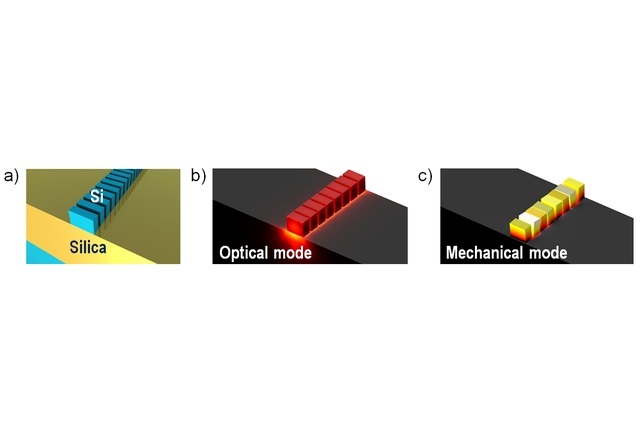Jan. 10, 2023
Integrated optomechanics finds increasingly broadening applications, requiring tight confinement of photons and phonons within nanometric-scale photonic circuits. However, most existing integrated optomechanical devices use unconventional materials or suspended structures that hinder co-integration with scalable photonic technologies. Here, Researchers show a new optomechanical confinement approach, using subwavelength structuration of silicon to tightly confine near-infrared photons and 600-MHz phonons in nonsuspended silicon waveguides, fully compatible with standard silicon photonics. Indeed, phonons are confined by velocity reduction in silicon and destructive interference of radiation to the cladding, while photons are confined by metamaterial index guiding.
The researchers experimentally demonstrate optomechanical microresonators with optical excitation and readout of mechanical modes with a record quality factor of 1120 for silicon-on-insulator devices, measured under ambient conditions and room temperature. The measured optical quality factor is ∼40,000, and the estimated coupling rate is 51 ± 18 kHz. These results are the first step for a new generation of optomechanical devices implemented with scalable silicon photonic technology, having great potential for applications in optical and wireless communications, radar, sensing, metrology, and quantum technologies.
Photon−phonon interactions in integrated waveguides hold the promise of new functions. A central problem to be solved in integrated optomechanical devices is the simultaneous confinement of photons and phonons. Several solutions have been demonstrated yet require nonstandard materials or suspended geometries challenging to integrate with scalable on-chip photonic technologies.
Here, the researchers present a new approach to achieving tight photon−phonon confinement, optical excitation, and the readout of mechanical modes in SOI waveguides without suspended structures. The proposed optomechanical waveguide geometry comprises a periodic array of nanometric-scale Si segments.
Optical diffraction effects are suppressed by choosing a sub-wavelength period. At the same time, phonon radiation is suppressed by destructive mechanical interference among Si segments when the excitation of adjacent pillars is shifted by π, as expected from the antenna array effect.
This strategy allows tight phonon confinement in silicon for modes while satisfying energy and momentum conservation conditions for optomechanical coupling. Optomechanical coupling is driven by the radiation pressure force exerted by the transverse electric (TE) optical mode, which can be enhanced by intensifying the electric field within the air gaps. The researchers fabricated the optomechanical resonator using the standard silicon photonic process based on electron-beam lithography and dry etching.
Experimental measurements were performed at room temperature and atmospheric pressure, and the dynamics of optomechanical coupling were characterized by recording the RF power spectral density (PSD) of the light reflected from the cavity. They observed several mechanical resonances near 0.66 GHz, with a mechanical quality factor of up to 1120. From the frequency dynamics and the intracavity power, They estimated a coupling rate of g0/2π = 51 ± 18 kHz between the mechanical and near-infrared optical modes.
These initial results demonstrate the effectiveness of the phonon confinement approach. By combining concepts from antenna theory, metamaterial engineering, and nano-optomechanics to overcome the photon−phonon confinement challenge in SOI, the strategy proposed here opens a new playground for integrated optomechanics: nonsuspended optomechanical devices compatible with Si optoelectronics.
References:
Genetic optimization of Brillouin scattering gain in subwavelength-structured silicon membrane waveguides
Jianhao Zhang, Paula Nuño Ruano, Xavier Le-Roux, Miguel Montesinos-Ballester, Delphine Marris-Morini, Eric Cassan, Laurent Vivien, Norberto Daniel Lanzillotti-Kimura, and Carlos Alonso Ramos
ACS Photonics 2022 9 (12), 3855-3862
DOI: 10.1021/acsphotonics.2c00791
Affiliation: Centre de Nanosciences et de Nanotechnologies, CNRS, Université Paris-Saclay, 10 boulevard Thomas Gobert, 91120, Palaiseau, France













